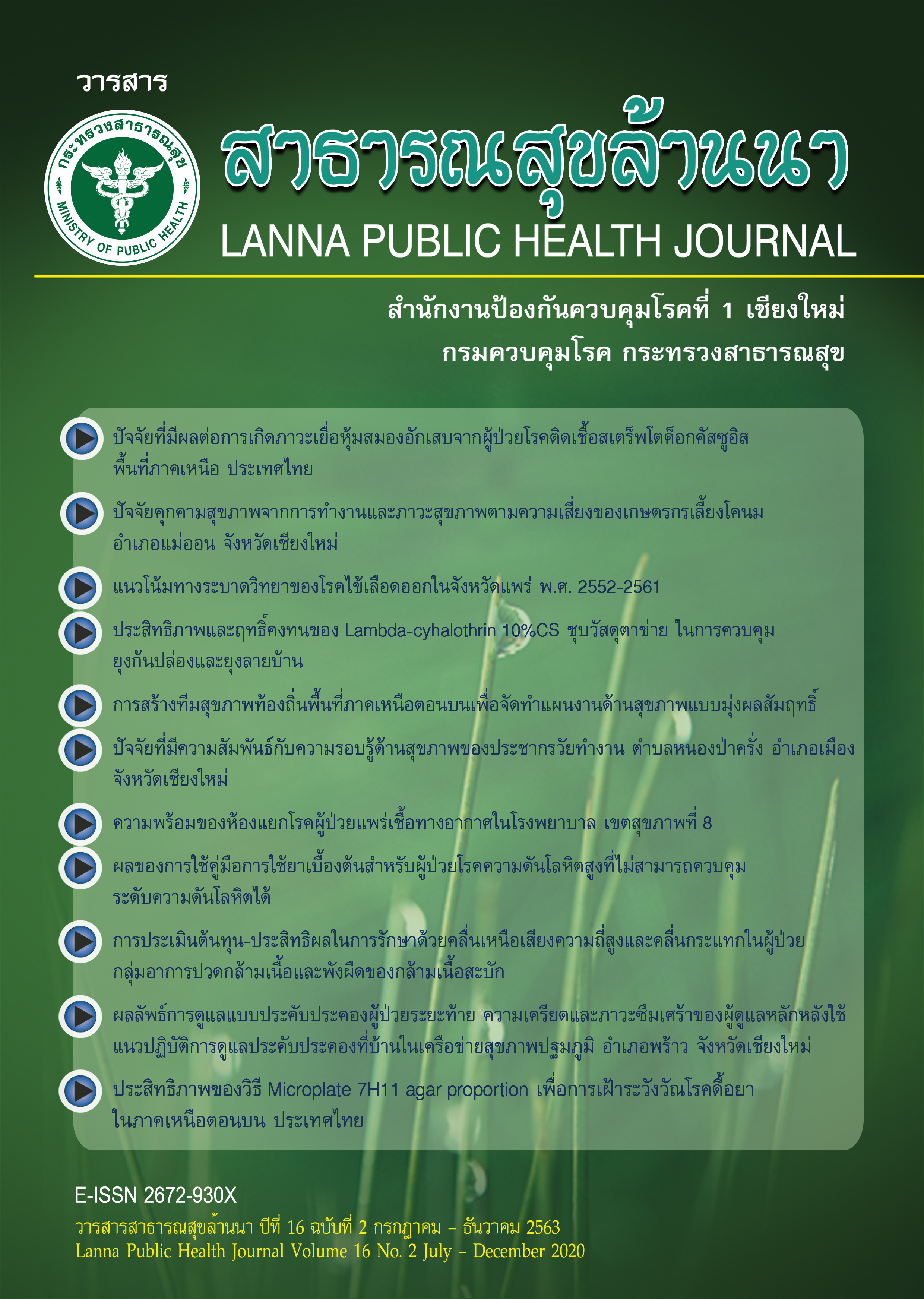ประสิทธิภาพและฤทธิ์คงทนของ Lambda-cyhalothrin10%CS ชุบวัสดุตาข่าย ในการควบคุมยุงก้นปล่องและยุงลายบ้าน
คำสำคัญ:
แลมป์ด้าไซฮาโลทริน, การควบคุมยุงพาหะนำโรค, ยุงลายบ้าน, ยุงก้นปล่องมินิมัส, วัสดุชุบสารเคมีบทคัดย่อ
การศึกษาครั้งนี้มีวัตถุประสงค์เพื่อศึกษาประสิทธิภาพและฤทธิ์คงทนของ Lambda-cyhalothrin10%CS ชุบเสื้อและผ้าคลุมตาข่ายที่ความเข้มข้น 30 มิลลิกรัมต่อตารางเมตร ทำการทดสอบกับยุงก้นปล่องชนิดมินิมัสสายพันธุ์ห้องปฏิบัติการ และชุบผ้าตาข่าย ขนาด 30, 60 และ 120 มิลลิกรัมต่อตารางเมตร ทดสอบกับยุงลายบ้านสายพันธุ์ห้องปฏิบัติการและสายพันธุ์จังหวัดระยอง และศึกษาความไวของยุงลายบ้าน สายพันธุ์จังหวัดระยอง ต่อสารเคมี Lambda-cyhalothrin โดยทดสอบตามแนวทางขององค์การอนามัยโลก ผลการศึกษาพบว่า เสื้อคลุมตาข่ายชุบด้วยสารเคมี Lambda- cyhalothrin10%CS มีฤทธิ์ในการควบคุมยุงก้นปล่องได้นานกว่า 7 เดือน โดยมีอัตราตายมากกว่า ร้อยละ 80 และผ้าตาข่ายชุบสารเคมีมีฤทธิ์ในการควบคุมยุงลายบ้านสายพันธุ์ห้องปฏิบัติการ ได้นานกว่า 6 เดือนทุกความเข้มข้น แต่ไม่มีประสิทธิภาพในการควบคุมยุงลายบ้านสายพันธุ์จังหวัดระยอง สำหรับการทดสอบความไวของยุงลายบ้านสายพันธุ์จังหวัดระยองต่อ Lambda-cyhalothrin พบว่ามีความต้านทานต่อสารเคมีชนิดนี้ โดยมีอัตราตายร้อยละ 8.13 และ 44.33 ที่ความเข้มข้นมาตรฐาน 0.03% และ 0.15% ตามลำดับ ดังนั้นการใช้ Lambda-cyhalothrin10%CS ในการชุบวัสดุให้มีฤทธิ์ตกค้างสามารถควบคุมยุงก้นปล่องชนิดมินิมัสได้ดีกว่ายุงลายบ้าน อย่างไรก็ตามก่อนจะนำไปขยายผลใช้ในพื้นที่ขนาดใหญ่ควรมีการศึกษาผลข้างเคียงและการยอมรับจากประชาชนกลุ่มเป้าหมายด้วย
References
บุญเสริม อ่วมอ่อง, จิราภรณ์ เสวะนา, บุษราคัม สินาคม, ศิริพร ยงชัยตระกูล และยุทธพงศ์ หมื่นราษฎร์. (2561). การศึกษาใช้เสื้อคลุมตาข่ายนาโนชุบสารเคมีออกฤทธิ์ยาวนานเพื่อป้องกันไข้มาลาเรีย.วารสารควบคุมโรค, 44(4), 448-458.
สำนักโรคติดต่อนำโดยแมลง. (2557). คู่มือการทดสอบสารเคมี. นนทบุรี: โรงพิมพ์ชุมนุมสหกรณ์การเกษตรแห่งประเทศไทย จำกัด.
Capinera, J.L. (2005). Abbott's Formula. Encyclopedia of entomology. [online] [cited 2020 May]; Available from: URL: https://link.springer.com/referenceworkentry/10.1007%2F0-306-%0948380-7_4.
Chuaycharoensuk, T., Juntarajumnong, W., Boonyuan, W., et al. (2011). Frequency of pyrethroid resistance in Aedes aegypti and Aedes albopictus (Diptera: Culicidae) in Thailand. Journal of Vector Ecology, 36(1), 204-212.
Chareonviriyaphap, T., Bangs, M.J., Suwonkerd, W., Kongmee, M., Corbel, V. & Ngoen-Klan, R. (2013). Review of insecticide resistance and behavioral avoidance of vectors of human diseases in Thailand. Parasites & Vectors, 6(280), 1-28.
Henry, M.C., Assi, S.B., Rogier, C., et al. (2005). Protective Efficacy of Lambda-cyhalothrin reated Nets in Anopheles Gambiae Pyrethroid Resistance Areas of Côte d'Ivoire. The American Journal of Tropical Medicine and Hygiene, 73(5), 859–864.
Lenhart, A., Trongtokit, Y., Alexander, N. et al. (2013). A Cluster-Randomized Trial of Insecticide-Treated Curtains for Dengue Vector Control in Thailand. The American Journal of Tropical Medicine and Hygiene, 88(2), 254–259.
N' Guessan, R., Corbel, V., Akogbéto, M., & Rowland, M. (2007). Reduced Efficacy of Insecticidetreated Nets and Indoor Residual Spraying for Malaria Control in Pyrethroid Resistance Area, Benin. Emerging infectious diseases, 13(2), 199. [cited 2020 June]; Available from: URL: https://www.ncbi.nlm.nih.gov/pmc/articles/PMC2725864/
Okoh, N., Odikamnoro, O.O., & Uhuo, A.C. (2013). Lambdacyhalothrin (pyrethriod insecticide)-treated curtains, mats and blankets as alternative to insecticide treated bed-nets for mosquitoes control. European Journal of Experimental Biology, 3(2), 187-190.
Rizzo, N., Gramajo, R., Escobar, P., et.al. (2012). Dengue vector management using insecticide treated materials and targeted interventions on productive breeding-sites in Guatemala. BMC Public Health, 12(1), 931.
Somboon, P., Prapanthadara, L.A. & Suwonkerd, W. (2003). Insecticide susceptibility tests of Anopheles minimus s.l., Aedes aegypti, Aedes albopictus, and Culex quinquefasciatus in northern Thailand. The Southeast Asian Journal of Tropical Medicine and Public Health. 34(1), 87-93.
Sirisopa, P., Thanispong, K., Chareonviriyaphap, T. & Juntarajumnong, W. (2014). Resistance to Synthetic Pyrethroids in Aedes aegypti (Diptera: Culicidae) in Thailand. Agriculture and Natural Resources, 48(4), 577-586.
Chavasse, D. C., Yap, H. H., & World Health Organization. (1997). Chemical methods for the control of vectors and pests of public health importance.
World Health Organization. (1998). Test procedures for insecticide resistance monitoring in malaria vectors, bio-efficacy and persistence of insecticides on treated surfaces: report of the WHO informal consultation.
World Health Organization. (2006). Pesticides and their application for the control of vector and pest of public health importance. 6thed.
World Health Organization. (2013). Guidelines for laboratory and field testing of long-lasting insecticidal nets.
World Health Organization. (2013). Test procedures for insecticide resistance monitoring in malaria vector mosquitoes. 2nd ed.
World Health Organization. (2016). WHO recommended insecticide products for treatment of mosquito nets for malaria vector control. [online] [cited 2020 June]; Available from: URL: https://www.paho.org/hq/dmdocuments/2016/2016-cha-insecticide-list-treat-malaria.pdf







